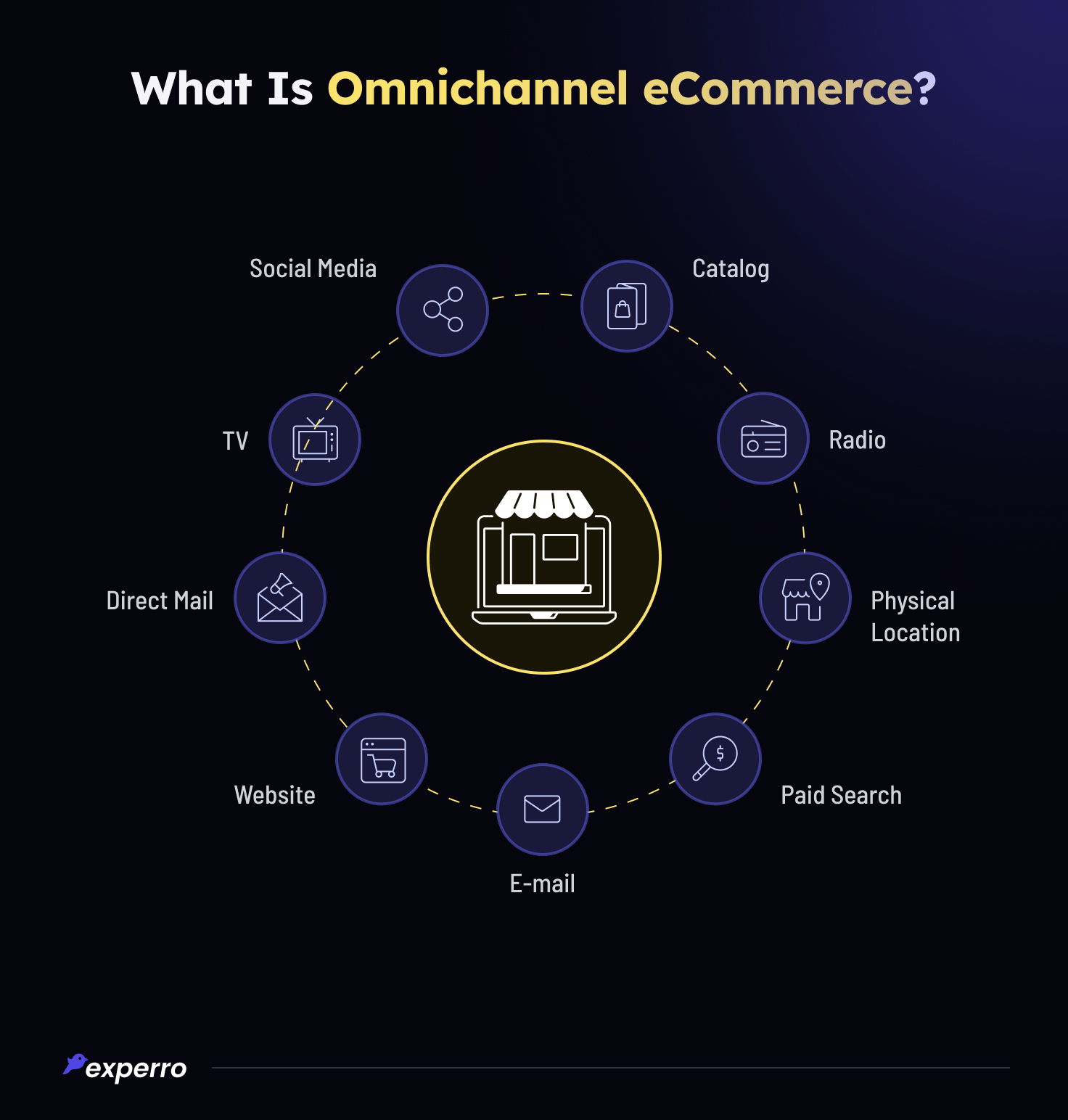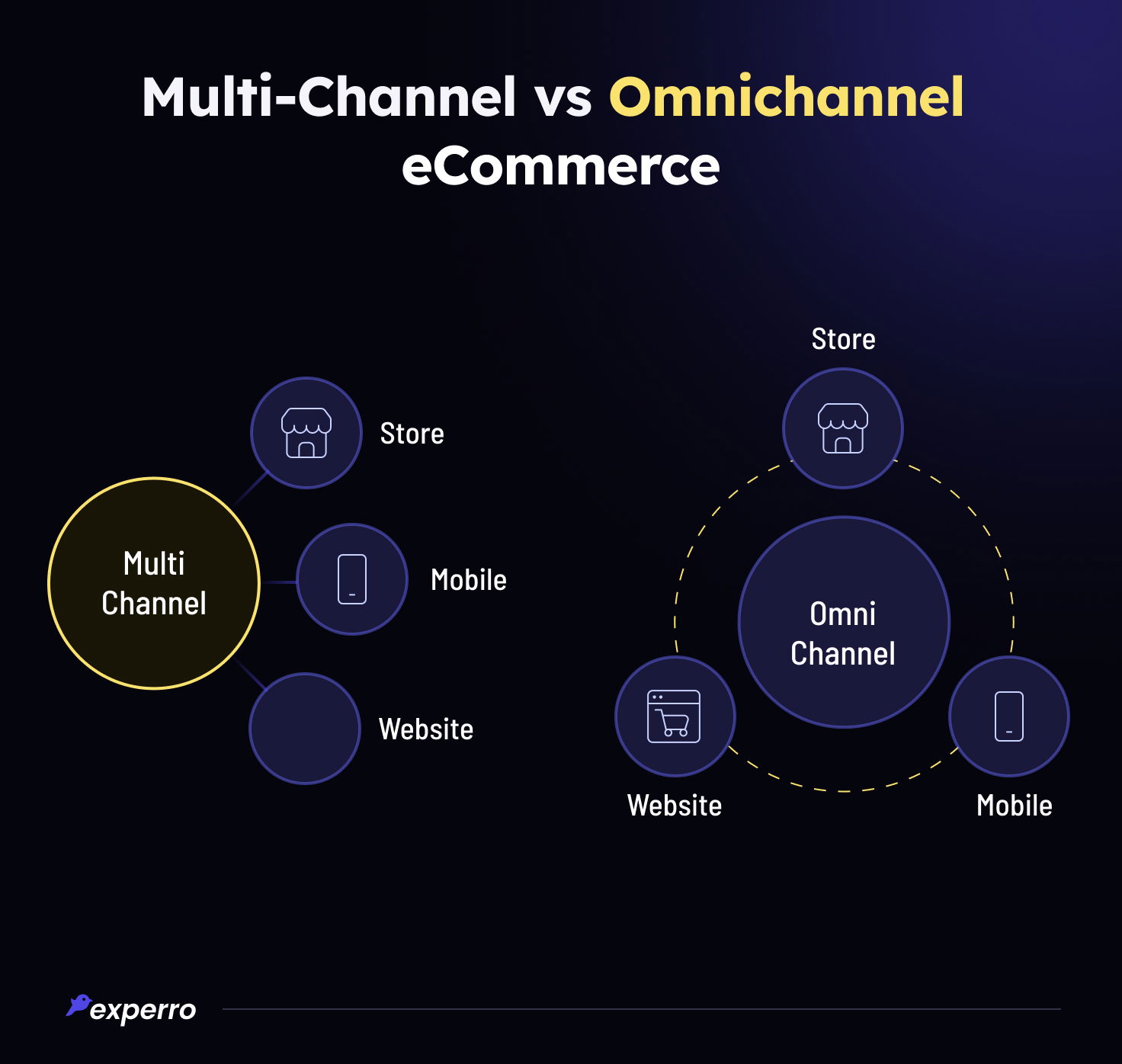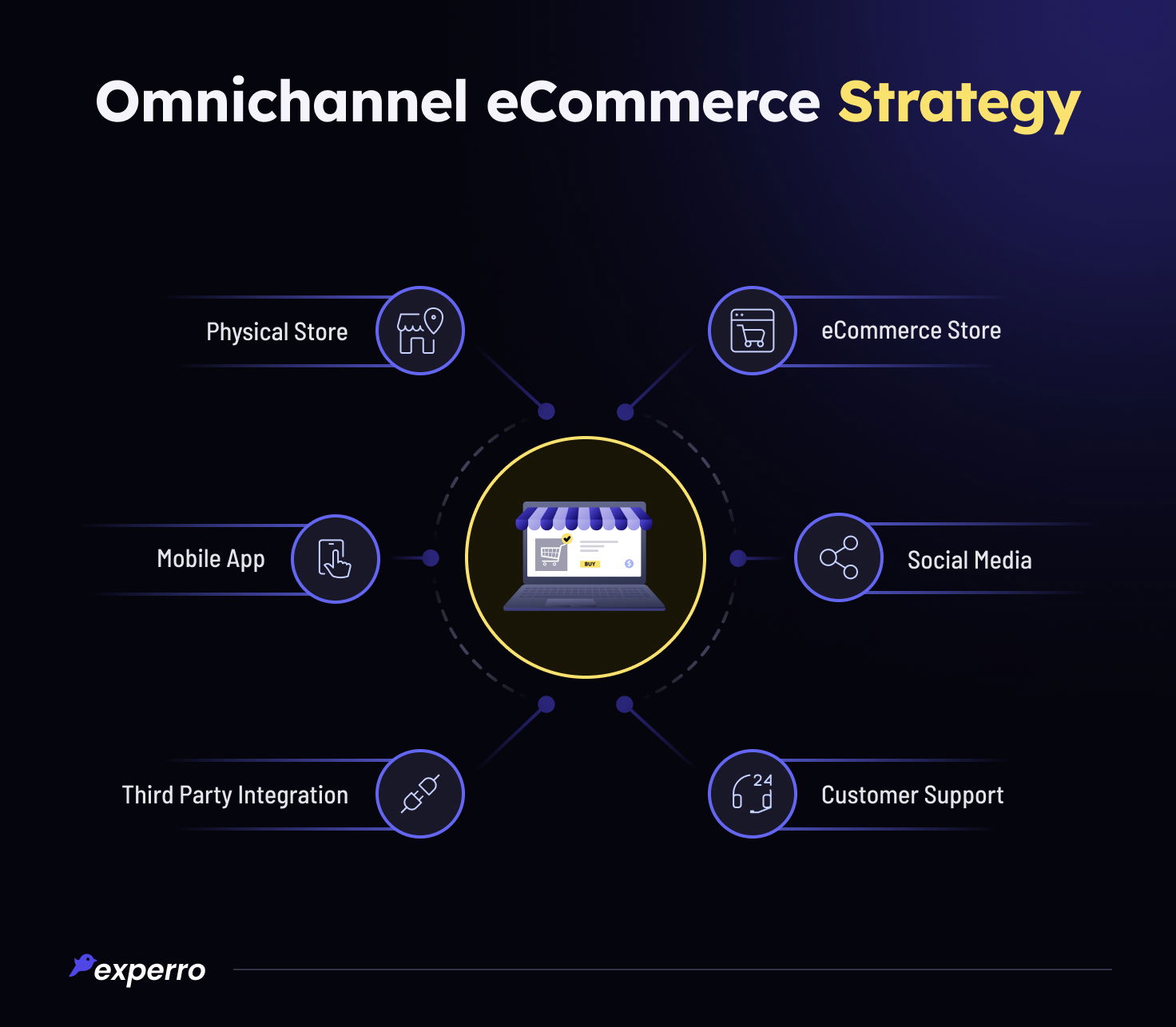A Complete Guide to Master Omnichannel eCommerce

What’s Inside
- What Is Omnichannel eCommerce?
- Omnichannel eCommerce Example
- Difference Between Omnichannel vs. Multichannel eCommerce
- Is Omnichannel the Future of eCommerce?
- Start Driving More Revenue with Omnichannel eCommerce
- How To Create an Effective Omnichannel eCommerce Strategy?
- 6. Implement a Dynamic Pricing Strategy
- Maximize Reach & Minimize Efforts by Enabling Omnichannel eCommerce
- Conclusion
Key Takeaways
- Companies with strong omnichannel customer engagement retain 89% of their customers.
- The omnichannel eCommerce allows customers to engage seamlessly across both digital and brick-and-mortar platforms.
- Omnichannel presence empowers businesses with deeper customer understanding through various channels.
- Omnichannel strategy not only enhances revenue but also elevates brand visibility and recognition.
Relying solely on individual channels for sales is no longer sufficient. Even a multichannel presence may not be sufficient in today's digital landscape. Modern consumers seek an integrated and uninterrupted shopping journey across every touchpoint.
If you are wondering what that means, we are talking about omnichannel eCommerce. Whether you want to boost sales, reach out to a broader audience, or increase brand awareness, the omnichannel eCommerce approach has got you covered!
Are you aware of this? A statistic says that 59% of consumers are interested in shopping online and picking up the product from the store.
Imagine a customer who prefers browsing products on a mobile device but wishes to see the item at a physical store before purchasing. It's important for eCommerce proprietors to ensure a frictionless transition between these channels, offering a seamless shopping journey.
That is why, in this blog, we will explain the meaning of omnichannel eCommerce and understand how to build an effective omnichannel eCommerce strategy.
What Is Omnichannel eCommerce?

Meaning - Omnichannel eCommerce refers to an approach of selling products and services across multiple channels, including in-store and online mediums.
An eCommerce omnichannel strategy aims to ensure consistent and unified customer interactions no matter whichever channel the customer chooses to buy from.
It blurs the lines between different marketing channels to offer customers a seamless shopping journey. It integrates the experience whether customers are online or a brick-and-mortar store.
For instance, whether a customer sends an inquiry via social media, email, or a mobile website, their information and past interactions are readily available to the representative. Hence, it leads to a more informed and efficient customer service team.
Gen AI-based omnichannel experiences acknowledge the various ways modern customers shop. It aims to ensure that customers have a positive experience at every touchpoint with the brand.
Let’s understand it in detail with the example of an omnichannel eCommerce platform.
Omnichannel eCommerce Example
For instance, a person discovers a beautiful jewelry piece through a company’s social media page. Drawn in by the stunning jewelry photography, they decide to explore more pieces by visiting the company’s website.
After browsing products, the customer wishes to see them in the physical store. They use the website to check the real-time updates of product availability of their chosen product in the nearby store. And the customer finally makes a purchase.
Difference Between Omnichannel vs. Multichannel eCommerce

Multichannel and omnichannel eCommerce are both distinct concepts that are often misunderstood by marketers.
Both of these approaches involve being present on multiple channels, but the omnichannel in eCommerce differentiates itself by integrating shopping journeys. Let’s understand it better from the table below:
Aspect | Omnichannel eCommerce | Multichannel eCommerce |
|---|---|---|
| Meaning | Provides a seamless and unified customer experience across multiple touchpoints. | It involves selling products or services for multiple touchpoints. |
| Integration | Channels are highly integrated, where inventory, sales, and customer data are synchronized. | Channels are not fully integrated. |
| Customer experience | Offers a consistent customer experience, regardless of the channel customers use. | Customer experience may vary between channels. |
| Coordination | Offers buy online, pick up in-store (BOPIS), & buy online return in-store (BORIS). | There is no coordination between different sales channels. |
| Brand consistency | Ensures consistent branding and identity across different omnichannel sales channels. | Branding may vary between media, leading to a less cohesive brand image. |
| Customer journey | Offers a seamless transition between channels during the customer’s purchase journey. | The customer's journey may involve more distinct steps when switching between channels. |
Deep dive into the difference omnichannel vs multichannel here.
Is Omnichannel the Future of eCommerce?
Did you know that companies with omnichannel customer engagement strategies retain, on average, 89% of their customers?
Omnichannel eCommerce acknowledges evolving consumer behavior. With the unprecedented rise of smartphones and evolving technology, customers expect a cohesive experience whether they shop online or offline.
Another interesting statistic says that the global eCommerce market is expected to total $6.3 trillion in 2023. In such a cluttered market, staying competitive and future-proofing business is important.
Omnichannel eCommerce allows to futureproof the business by adapting emerging channels and technologies. It ensures that businesses remain relevant for customers in a changing digital landscape.
A new social media platform gaining popularity among the target audience? Businesses can quickly launch their marketing strategy on that particular channel. This helps businesses to tap into a broader audience and adapt to emerging trends.
Let’s say augmented reality technology has become a prevalent tool for virtual trials in the fashion industry. An Omnichannel eCommerce owner can seamlessly integrate functionality on their website and mobile app, allowing customers to virtually try on clothing before making a purchase.
This not only enhances the online shopping experience but also differentiates them in a competitive market.
Omnichannel is undoubtedly the future of eCommerce as it provides customers with the convenience of shopping from both online and offline mediums.
Moreover, by offering a consistent and seamless experience, businesses can enhance customer satisfaction, leading to increased customer loyalty and customer retention.
How To Create an Effective Omnichannel eCommerce Strategy?

Building a successful omnichannel strategy requires careful planning and seamless integration between various channels.
Based on the recent omnichannel retail trends, we have compiled the steps to consider while creating an omnichannel eCommerce strategy.
1. Market Research & Target Audience
The first step of the omnichannel eCommerce strategy is to conduct market research to understand your industry, competitors, and trends. Identify your target audience’s preferences, behaviors, and pain points.
Ask the following questions to understand your audience:
- Who are your customers?
- What do they want?
- Which channel do they interact most on?
- Do they prefer to shop from mobile devices or desktops?
- What is their age, demographics, and income?
This information forms a foundation for your omnichannel strategy to meet the specific needs of the customers.
For instance, if you’re selling sports equipment, your market research might reveal the ratio of male and female buyers on your website. This might help you to manage the inventory of different gender-based products on the website.
2. Develop a Strong Brand Identity
Two thirds of the businesses say creating a consistent brand experience increases the revenue by 10%.
Much like a physical store, the appearance of your digital store on the website is crucial. The key here is to craft a distinctive and attractive appearance for your stores.
This helps to create a strong brand identity. It sets the tone for how your brand is perceived across all channels. The following aspects might help to build a strong brand identity.
- Storefront
A well-designed eCommerce storefront creates a visually appealing and memorable first impression. It conveys professionalism, creativity, and a sense of purpose with your brand’s value and personality.
- Mobile-first approach
Prioritizing a mobile-first eCommerce experience ensures that your brand represents consistency across all devices.
Moreover, you cater to a segment of users who prefer using their smartphones for online shopping. This omnichannel eCommerce strategy strengthens your brand’s reach and appeal.
3. Establish Omnichannel eCommerce Presence
Different customers have different preferences when it comes to shopping. Some may prefer browsing on a website, while others may prefer mobile apps.
And some may like seeing products in the physical store. However, storing the large amount of data from different channels might be a daunting task.
4. Provide a Unified Omnichannel Customer Experience
Providing a unified eCommerce customer experience is important. Implement technologies and systems that enable real-time data synchronization across all channels.
This ensures that the customer information, purchase history, and inventory levels are updated. The integration is essential for customers who want to switch between channels effortlessly.
For instance, if you have an online clothing store, you would like to ensure that your in-store inventory matches are available online. This way, customers can visit your store or website and find the same options.
5. Cross-Channel Gamification
The cross-channel gamification in omnichannel commerce involves interactive and game-like elements across various sales channels of the brand.
The aim is to encourage customer participation, loyalty, and interaction with the brand for different customer touchpoints.
Here, customers may earn points, badges, or rewards that are accessible across all channels. The reward system through games is strategically employed to motivate specific customer behaviors. It involves making a purchase, referring to a friend, or writing reviews.
With gamification, businesses can increase eCommerce sales and potentially create new advocates. Customers who enjoy this activity are more likely to return and refer others to join.
6. Implement a Dynamic Pricing Strategy
Implementing a dynamic pricing strategy in your omnichannel business model can significantly increase your sales. It considers aspects such as demand, seasonality, and competitor’s pricing.
It also involves delivering an omnichannel personalized experience to customers based on their demographic or behavior.
For instance, during a high-demand period, prices could be set upward. Or it can be offering discounts during off-peak seasons to stimulate demand.
7. Predictive Analytics and Trend Forecasting
Predictive analytics involves using data algorithms to make predictions about future trends or customer behavior. For example, it helps to anticipate which type of product will be popular in the coming months so you can stock up on your online channels.
This omnichannel eCommerce strategy is about keeping an eye on what’s popular in the market and predicting what will be in demand. It helps you to stay ahead of the curve and offer products that your customers will want.
For instance, if you run a fashion store, predictive customer analytics might help you predict which style will be popular in the next season, and trend forecasting enables you to decide what to stock based on these predictions.
Conclusion
In the rapidly evolving eCommerce landscape, adopting an omnichannel eCommerce approach has become not only important but necessary for businesses. It is no longer a choice.
Since this comprehensive strategy seamlessly integrates online and offline channels, it is most convenient for customers.
Furthermore, omnichannel marketing ensures that customers have a seamless shopping experience irrespective of the channels they choose to continue their purchase journey from.
So, it's like a fundamental aspect to success in this dynamic digital era. It is helpful in securing a thriving presence in the eCommerce industry.
To create such an excellent omnichannel eCommerce experience, book a demo with Experro today!
FAQs


Priya Zala
25 June 2024Through her writing, she has a lovely way of capturing users' pain points and delivering solution-oriented content. Her writing is sure to captivate readers and leave them with a lasting impression. When not crafting content, Priya enjoys getting lost in a good work of fiction, which soothes her soul.